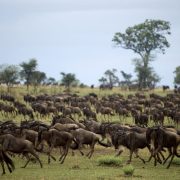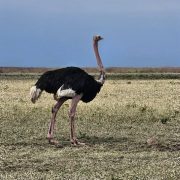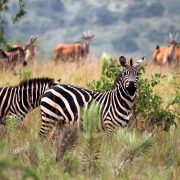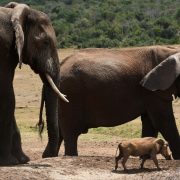Tanzania National Parks
Tarangire National Park
Tarangire National Park, covering approximately 2,850 square kilometers, is located in northern Tanzania, just south of Lake Manyara and part of the larger Manyara Region ecosystem. It is a haven of seasonal swamps, ancient baobab trees, and a rich diversity of wildlife.
- 3.8333° S, 36.0833° E
Famous for its large elephant herds and iconic baobab-studded landscapes, Tarangire National Park offers a uniquely intimate safari experience. It may be less visited than its famous neighbors, but its dense concentration of wildlife—particularly during the dry season—makes it one of Tanzania’s hidden safari gems.
Tarangire’s lifeline is the Tarangire River, which attracts thousands of animals during the dry season (June–October), turning the park into a bustling wildlife corridor. In addition to elephants, the park is home to buffaloes, giraffes, zebras, wildebeests, and numerous predators. Birdwatchers will find over 500 species here, making it a true birding paradise.
Authentic Tarangire safari
A classic safari destination known for its peaceful atmosphere, ancient baobab trees, seasonal swamps, and enormous elephant populations. Game-viewing is most dramatic during the dry season when animals gather at the Tarangire River.
GEOGRAPHIC SIZE
2,850 km²
MAMMAL SPECIES
95+
BEST TIME TO VISIT
June to October (Dry Season)
MOST FAMOUS FOR
Large elephant herds and giant baobabs

Riverine Forests:
Along the Tarangire River, lush corridors support elephants, buffaloes, and various primates while attracting predators during the dry season.

Baobab Woodlands:
Ancient baobabs dominate the landscape, creating a unique backdrop for wildlife viewing and harboring owls, bats, and other species.

Acacia Savannahs:
Grasslands and scattered acacias house impalas, zebras, giraffes, lions, and migratory animals—particularly rich in biodiversity during the dry season.

Swamps & Floodplains:
The Silale Swamp and surrounding wetlands host waterbirds, elephants, and rare antelope like fringe-eared oryx and gerenuk, especially during wet months.
Wildlife & Birds
Tarangire National Park boasts an impressive variety of wildlife, especially known for hosting Tanzania’s largest elephant population. Massive herds gather around the Tarangire River during the dry season, creating unforgettable sightings. Lions, leopards, and cheetahs patrol the grasslands, while giraffes, zebras, wildebeests, buffaloes, and warthogs roam freely—making every safari feel alive with movement.
The park is also a paradise for bird lovers, with over 550 recorded bird species, including yellow-collared lovebirds, bateleur eagles, hornbills, and the striking lilac-breasted roller. Unique creatures like fringe-eared oryx, gerenuks, and greater kudu can also be spotted here. Tarangire’s rich wildlife diversity and peaceful atmosphere make it a must-visit for both seasoned safari-goers and first-time adventurers.





Tarangire Weather
DRY SEASON
June to October & Mid-December to February
WET SEASON
March to May & November to early December
Tarangire National Park Map
Tarangire National Park FAQ's
General Tarangire Information:
1. Where is Tarangire National Park located?
Tarangire lies in northern Tanzania, about 120 km southwest of Arusha, making it easily accessible on the Northern Circuit safari route. It forms part of the larger Manyara ecosystem and is bordered by Lake Manyara and Maasai steppe lands.
2. How large is Tarangire National Park?
The park spans approximately 2,850 square kilometers and includes diverse habitats ranging from riverine forests to floodplains, offering refuge to a variety of animals year-round, especially during the dry season when wildlife density peaks.
3. What is Tarangire National Park famous for?
Tarangire is famous for its massive elephant herds, ancient baobab trees, and seasonal migration. It’s especially vibrant in the dry season when large numbers of animals gather at the Tarangire River, creating dramatic wildlife scenes.
4. What wildlife can I expect to see in Tarangire?
Expect to see elephants, lions, giraffes, zebras, wildebeests, leopards, and even rarities like the fringe-eared oryx and lesser kudu. The park is also a hotspot for birdlife, including ostriches, hornbills, and brightly colored bee-eaters.
5. Is Tarangire National Park safe for tourists?
Yes, Tarangire is a safe and welcoming safari destination. Guided by licensed operators and experienced rangers, visitors enjoy a secure experience with adherence to conservation and safety regulations while respecting wildlife and park boundaries.
6. When is the best time to visit Tarangire?
The best time to visit is during the dry season (June to October), when wildlife is concentrated along the river. However, the wet season (November to May) offers lush scenery, bird migrations, and fewer crowds.
7. What types of safaris are available in Tarangire?
Visitors can enjoy game drives, night drives (in nearby concessions), walking safaris, and cultural excursions. Each experience offers a different perspective on the park’s beauty, wildlife, and surrounding community traditions.
8. How do I get to Tarangire National Park?
Tarangire is a 2–3 hour drive from Arusha and is often the first stop on Northern Circuit safaris. Private airstrips also allow for fly-in safaris via charter flights from Arusha or Serengeti.
9. What should I pack for a Tarangire safari?
Pack neutral-colored clothing, sun protection (hat, glasses, sunscreen), comfortable walking shoes, binoculars, insect repellent, and a good camera. During cooler months (June–August), bring a warm layer for early mornings and evenings.
10. Are there luxury accommodations in Tarangire?
Yes, options range from rustic lodges to high-end tented camps. Notable names include Tarangire Treetops by Elewana, Sanctuary Swala Camp, Lemala Mpingo Ridge, and Baobab Tented Camp, offering comfort, views, and exceptional service.
The Dry Season Wildlife Spectacle
1. Why is Tarangire’s dry season famous?
During the dry season (June–October), animals from surrounding regions migrate to the Tarangire River, the only reliable water source. The spectacle includes hundreds of elephants, predator-prey interactions, and a rich variety of herbivores in large numbers.
2. What makes Tarangire different from Serengeti?
Tarangire is quieter, more intimate, and features distinct baobab landscapes. While Serengeti is famous for the Great Migration, Tarangire is known for its elephant herds, unique flora, and seasonal wildlife density along its life-sustaining river.
3. Can I do a walking safari in Tarangire?
Yes, guided walking safaris are available in designated park zones and nearby conservation areas. Led by professional guides and rangers, these walks offer close encounters with nature, tracking skills, and deeper understanding of the ecosystem.
4. Are there rare animals in Tarangire?
Yes, Tarangire is one of the few places in Tanzania where you might see fringe-eared oryx, greater kudu, and African wild dogs. Its habitats support species not commonly found in other parks on the Northern Circuit.
5. Is Tarangire good for photography?
Absolutely. The baobab-strewn landscapes, golden dry-season light, dramatic skies, and abundant wildlife create ideal conditions for photography. Both wide-angle and telephoto opportunities abound, especially near waterholes and during elephant interactions.
6. Is Tarangire suitable for family safaris?
Yes, it’s excellent for families, especially during shorter trips. Many lodges offer family tents, child-friendly meals, and educational wildlife experiences. The park’s accessibility and manageable size make it ideal for younger travelers.
7. Can I combine Tarangire with other parks?
Yes, it pairs perfectly with Lake Manyara, Ngorongoro Crater, and Serengeti National Park for a full Northern Circuit safari. Many itineraries start with Tarangire, building up to the larger parks for a well-rounded adventure.
8. What kind of accommodations are near the park entrance?
Several midrange and budget-friendly options are available near the main gate and in Mto wa Mbu or Karatu, including Tarangire Safari Lodge, Lake Burunge Tented Camp, and Whistling Thorn Camp—each offering great views and access.
9. What birds can be seen in Tarangire?
You can spot hornbills, guinea fowls, kori bustards, lovebirds, yellow barbets, and bee-eaters. The Silale Swamp is particularly rich in waterbirds such as herons, storks, and African jacanas.
10. Why is Tarangire important for conservation?
Tarangire is part of a crucial migratory corridor and ecosystem that connects several wildlife zones. It helps preserve biodiversity, supports local livelihoods through tourism, and acts as a stronghold for elephants and lesser-known species.
More Facts
- Elephant Paradise: Tarangire is home to one of Africa’s largest elephant populations, with herds numbering in the hundreds—often seen bathing, feeding, or socializing by the riverbanks and swamps.
- Unique Flora & Baobab Trees: The park is renowned for its towering baobab trees, some over a thousand years old, which dominate the landscape and serve as water storage during dry months.
- Dry Season Game Viewing: From June to October, animals migrate into Tarangire’s river system from surrounding areas, providing one of the highest concentrations of wildlife outside Serengeti.
- Birdwatching Destination: With over 500 bird species, including kori bustards, yellow-collared lovebirds, and hammerkops, Tarangire is a haven for both novice and seasoned birders.
- Cultural Excursions: Visitors can enjoy cultural interactions with the Barabaig and Maasai communities around the park, learning about their pastoral lifestyles, traditions, and crafts.
Tarangire National Park Safari Deals
Our Selected Accommodation
- Budget Accommodation, Karatu
Kudu Lodge and Campsite
Kudu Lodge and Campsite is a charming mid-range accommodation nestled in the heart of Karatu,
- Karatu, Midrange Accommodation
Eileen’s Trees Inn
Eileen’s Trees Inn is a welcoming country lodge located on the edge of Karatu town
- Karatu, Luxury Accommodation
Ngorongoro Coffee Lodge
Ngorongoro Coffee Lodge is a luxurious retreat nestled on the edge of the Ngorongoro Forest

Why ETA?
Explore Trekking Adventure (ETA) offers expertly guided treks, authentic cultural experiences, and responsible travel. With local knowledge, quality gear, and personalized service, ETA ensures safe, unforgettable journeys across East Africa.
